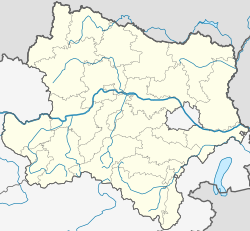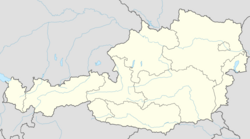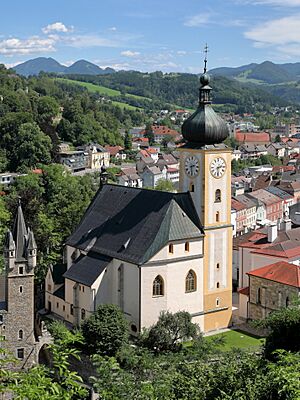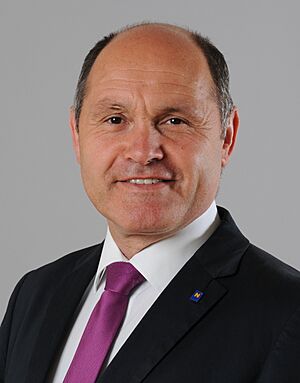Waidhofen an der Ybbs facts for kids
Quick facts for kids
Waidhofen an der Ybbs
Waidhofen an der Ybbs
|
|||
|---|---|---|---|
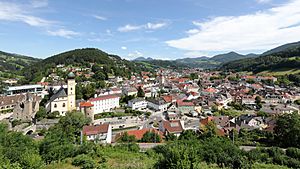
Waidhofen an der Ybbs, centre
|
|||
|
|||
| Country | Austria | ||
| State | Lower Austria | ||
| District | Statutory city | ||
| Area | |||
| • Total | 131.57 km2 (50.80 sq mi) | ||
| Elevation | 356 m (1,168 ft) | ||
| Time zone | UTC+1 (CET) | ||
| • Summer (DST) | UTC+2 (CEST) | ||
| Postal code |
3340
|
||
| Area code | 07442 | ||
| Vehicle registration | WY | ||
| Website | www.waidhofen.at | ||
Waidhofen an der Ybbs is a special kind of city in Lower Austria, a state in Austria. It's known as a "statutory city," which means it has its own local government, like a district.
The city was first mentioned in 1186. Since the 1300s, it has been an important economic hub for the Ybbstal region. In 2001, about 11,662 people lived there, and the city covers an area of 131.56 square kilometers.
Cool Places to See in Waidhofen
Exploring the Old City Center
Waidhofen's Old City has many old buildings. These include houses and public buildings. They are all surrounded by the city's original walls. You can still see old Gothic courtyards and arched walkways. Many buildings have been updated with beautiful new fronts. These designs come from styles like Biedermeier and Neo-Baroque.
The Historic Parish Church
The Stadtpfarrkirche is one of Waidhofen's biggest and oldest churches. It was built between 1470 and 1510. Inside, you'll find a Gothic winged altar. This altar was moved here from another church in the 1930s. The church's wooden main door is from when it was first built.
Rothschild Castle: A Journey Through Time
A castle has stood in this spot in the Old City since the 1100s. The oldest parts of the current building were built around 1400. For centuries, Bavarian governors lived here. This made the castle the main office for the region. The castle is named after a famous former owner, the banker Albert Salomon Anselm Freiherr von Rothschild.
The castle was greatly updated in the late 1800s. It was also redesigned in 2006 and 2007. Modern materials like glass and steel were added. In 2007, the castle hosted a big exhibition. Today, it has a park, a gift shop, and a tourism center. It also houses the 5e-Museum. This museum focuses on five elements: fire, water, wood, earth, and metal.
During Advent, the castle hosts the town's Christmas market. You can find crafts, food, and music there. Once a month during the school year, the castle turns into the "Crystal Club."
The Tall City Tower
The Stadtturm, or City Tower, is a main symbol of Waidhofen. It is 50 meters tall. You can see it from many miles away. It was built in the 1530s. The money came from a victory over invaders. An inscription from 1932 says: "In the year 1532 the citizens, smiths, and farmers forced the Turkish to flee, and built this tower in remembrance." One clock face is always set to 11:45. This remembers the time of the citizens' victory.
Ybbs Tower and City Gate
The Ybbsturm is another of Waidhofen's towers. It is the only medieval gate tower left in the city walls. The city's motto is written here in Latin. It means "Iron and Steel Nourish the City."
Mariensäule: A Historic Column
This column is in the center of the city. It has a figure of the Virgin Mary on top. It was built in 1665. It was a symbol of the Counter-Reformation.
Schwarzbach Viaduct: An Old Bridge
The Schwarzbachviadukt is a historic bridge from the late 1800s. It crosses the Schwarzbach (Black Stream) valley. This is just outside the city center. The narrow-gauge Ybbstalbahn uses it. This train line used to go from Waidhofen to Lunz am See. Now, it runs a shorter service across the city.
Krautberg: A Hill with a View
Krautberg is a small hill close to town. You can easily spot it by its large white cross. From here, you get a great view of the old city. To get there, start at the Stadt train station on Reichenauer Strasse. Cross the train tracks and follow the path called the Reinhold Klaus Weg.
Sonntagberg Basilica: A Pilgrimage Site
North of Waidhofen is an important Catholic pilgrimage site. It's called Wallfahrtskirche Basilika Sonntagberg. The church was built between 1706 and 1732. It is clearly visible from far away. Since 1964, it has been a minor basilica. You can walk there from Waidhofen (about 10 km). Or, you can take a short train ride to Rosenau. From there, it's a 5 km hike to the peak and the church.
Famous People from Waidhofen
Many interesting people have come from Waidhofen an der Ybbs:
- Ferdinand Andri (1871–1956), an architect.
- Alexander Lernet-Holenia, (1897—1976), a poet, novelist, and writer.
- Frieda Berryhill (1922–2012), an American activist for peace.
- Rainer Küchl, (born 1950), a violinist.
- Wolfgang Sobotka (born 1956), a teacher, conductor, and politician.
- Bert Ehgartner (born 1962), an author, journalist, and director.
- Babsie Steger (born 1968), a TV presenter, actress, dancer, and singer.
- Günther Groissböck (born 1976), an opera singer.
Sports Stars
- Georg Zellhofer (born 1960), a football manager and former player. He played 305 games.
- Richard Lietz (born 1983), a professional racing driver for Porsche.
- Kilian Fischhuber (born 1983), a rock climber who does bouldering and sport climbing.
- Melanie Klaffner, (born 1990), a tennis player.
Waidhofen in Books
The American novelist John Irving used Waidhofen an der Ybbs as a main setting. It appears in his early novel Setting Free the Bears.
An Honorary Title Removed
In May 2011, the city council of Waidhofen an der Ybbs made an important decision. They voted to officially remove an honorary citizenship that had been given a long time ago.
Sister Cities
Waidhofen an der Ybbs has special connections with other cities around the world. These are called "twin cities" or "sister cities."
- Tuttlingen, Baden-Württemberg, Germany
- Bischofszell, Thurgau, Switzerland
See also
 In Spanish: Waidhofen an der Ybbs para niños
In Spanish: Waidhofen an der Ybbs para niños




